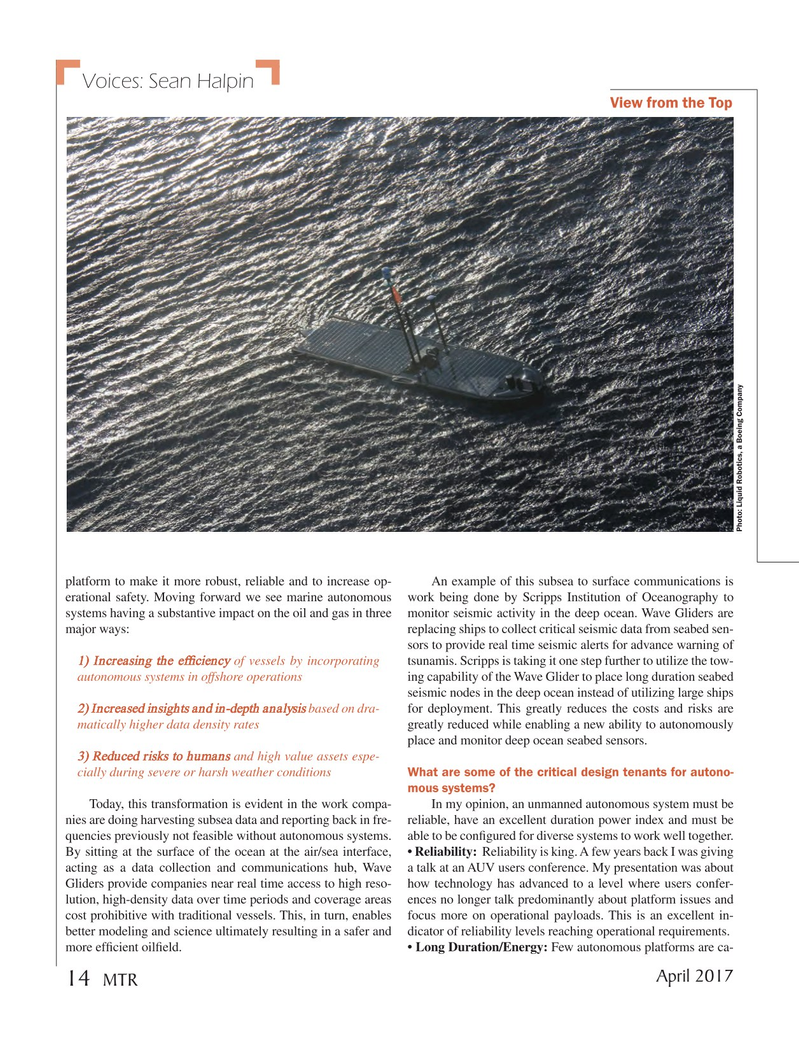
Page 14: of Marine Technology Magazine (April 2017)
Offshore Energy Annual
Read this page in Pdf, Flash or Html5 edition of April 2017 Marine Technology Magazine
Voices: Sean Halpin
View from the Top
Photo: Liquid Robotics, a Boeing Company platform to make it more robust, reliable and to increase op- An example of this subsea to surface communications is erational safety. Moving forward we see marine autonomous work being done by Scripps Institution of Oceanography to systems having a substantive impact on the oil and gas in three monitor seismic activity in the deep ocean. Wave Gliders are major ways: replacing ships to collect critical seismic data from seabed sen- sors to provide real time seismic alerts for advance warning of 1) Increasing the ef? ciency of vessels by incorporating tsunamis. Scripps is taking it one step further to utilize the tow- autonomous systems in offshore operations ing capability of the Wave Glider to place long duration seabed seismic nodes in the deep ocean instead of utilizing large ships 2) Increased insights and in-depth analysis based on dra- for deployment. This greatly reduces the costs and risks are matically higher data density rates greatly reduced while enabling a new ability to autonomously place and monitor deep ocean seabed sensors. 3) Reduced risks to humans and high value assets espe- cially during severe or harsh weather conditions What are some of the critical design tenants for autono- mous systems?
Today, this transformation is evident in the work compa- In my opinion, an unmanned autonomous system must be nies are doing harvesting subsea data and reporting back in fre- reliable, have an excellent duration power index and must be quencies previously not feasible without autonomous systems. able to be con? gured for diverse systems to work well together.
By sitting at the surface of the ocean at the air/sea interface, • Reliability: Reliability is king. A few years back I was giving acting as a data collection and communications hub, Wave a talk at an AUV users conference. My presentation was about
Gliders provide companies near real time access to high reso- how technology has advanced to a level where users confer- lution, high-density data over time periods and coverage areas ences no longer talk predominantly about platform issues and cost prohibitive with traditional vessels. This, in turn, enables focus more on operational payloads. This is an excellent in- better modeling and science ultimately resulting in a safer and dicator of reliability levels reaching operational requirements. more ef? cient oil? eld. • Long Duration/Energy: Few autonomous platforms are ca- 2017 April 14 MTR
MTR #3 (1-17).indd 14 MTR #3 (1-17).indd 14 3/30/2017 10:22:11 AM3/30/2017 10:22:11 AM

 13
13

 15
15
